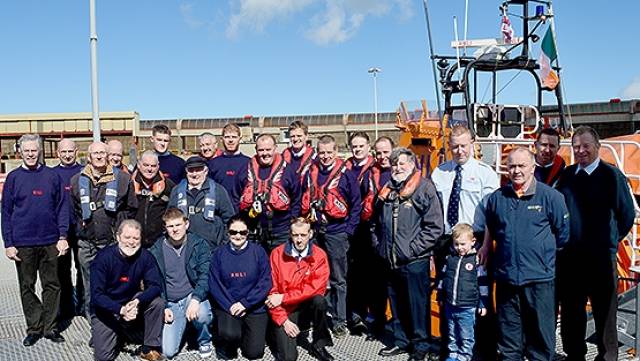Lifeboat crew past and present, family, fundraisers and well-wishers galore all gathered this weekend to wish one of Rosslare RNLI’s most well-known and respected lifeboat men, a long and happy retirement. Tony Kehoe spent 42 years volunteering with the RNLI as well as working as a fleet mechanic for the charity for a decade.
In a day filled with emotion Tony was taken out on a final lifeboat exercise with his colleagues. The railings down to the lifeboat had been lined with banners and Tony’s family, including his wife Veronica, daughter Sonia, son Brian, son-in-law Kieran, daughter-in-law Louise and grandchildren Robyn, Hannah, Darragh, Joe and Harry were there to witness his final lifeboat exercise. On returning to shore after the short trip, which brought them out past Tuskar Rock, members and supporters of Rosslare RNLI lined the walkway back to the lifeboat station and Tony shook everyone’s hand to receive congratulations and good wishes for a well-deserved retirement.
A reception was held later that evening at Culletons in Kilrane where family, friends and lifeboat people gathered to pay tribute. RNLI Divisional Operations Manager Owen Medland presented Tony with his RNLI Certificate of Service, which detailed every position Tony had held in the charity, including the many years he acted as second mechanic. Rosslare RNLI Deputy Launching Authority and Lifeboat Press Officer Jamie Ryan was the evening’s MC and speakers on the night included Rosslare RNLI Lifeboat Operations Manager David Maloney, Coxswain Eamon O’Rourke and representatives from the flanking lifeboat stations Kilmore Quay and Wexford RNLI with both Lifeboat Operations Manager Joe Maddock and Lifeboat Helm David Maguire paying their own tributes to Tony. Well known Rosslare resident Larry Dunne wrote a poem especially for the occasion.
Commenting on Tony’s retirement Rosslare Harbour RNLI Lifeboat Operations Manager David Maloney said, ‘We wanted to mark this event properly as Tony has been such an important person in Rosslare RNLI. He is a lifeboat man through and through and while he was never afraid to tell it like it is, he always had the interests of the crew and the lifeboat at his heart. He is one of the first people you would want on the lifeboat on a bad night and we have all benefitted from his advice and counsel over the years. I know we are not losing that and Tony will be a regular and welcome visitor to our door.’
It was Tony’s friendship with former Rosslare RNLI mechanic Matt Wickham that brought him onto the lifeboat back in 1974. His great uncle was Coxswain on the lifeboat for several years and he was born and reared beside the watchbox in Rosslare Port.
Tony reminisced about the changes that had occurred in the RNLI over the past forty years including that now, thankfully, there is a full kit for every crewmember on the lifeboat. Tony said, ‘ Back when I first joined there was one set of kit for the crew who went out on the lifeboat and whoever got there first got the best pair of boots and if you took a big pair of boats and a bigger fella came after you, that was it. There were no pagers so if you didn’t hear the maroon go off someone rapped on your door and off you went.’
Asked about the callouts during his time on the lifeboat crew, Tony said that the one that stood out in his memory was in 1978 with Coxswain Seamus McCormack, who received a bronze medal for the rescue of two fishing crew. Tony added, ‘It was to a Cornish fishing boat, Notre Dame du Sacre Coeur, she sank out there on a bad day. I was the youngest on that callout at just 22 years old. The crew had been trying to get into Milford Haven and a storm came on then and they lost power. During the night while they were adrift they had fired whatever distress signals they could. It was around noon that day when they were burning some stuff in a drum on the deck and a freighter spotted them and raised the alarm and we were launched.’
‘The freighter made a bit of a lee for us and we got a couple of men off it and the RAF helicopter took one man off. We took them off in very difficult seas. It was a bad day with a bad sea and an old lifeboat but everyone was saved and the crew all stayed in Rosslare that night and departed on the ferry the next day.’
Tony’s parting words of advice for his lifeboat crew as he enjoys his well-deserved retirement were short and to the point, ‘Mind yourselves and look out for one another.’






























































